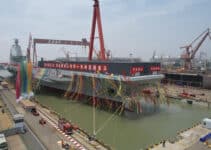President Joe Biden’s recent visit to India and Vietnam marked one of the administration’s recent signals for economic and technological “de-risking” with China. The trip followed Biden’s executive order, issued in August, that vowed to block U.S. venture capital and private equity investment in Chinese firms working on sensitive technologies such as semiconductors, artificial intelligence, and quantum computing.
An era of global venture capital appears to be coming to a close. As Washington attempts to limit cross-border capital flows, however, America might be at risk of forfeiting its own access to Chinese technology and long-standing commitment to global investment.
While the executive order is intended to be narrow and targeted at military acquisitions of key technology, it epitomizes a broader trend of increasing scrutiny on high-tech venture investment relationships between the U.S. and China. In a high-profile rebranding, Sequoia Capital recently spun off its highly successful China arm in June. Four U.S. venture firms were notified in July that the House Select Committee on the Chinese Communist Party was probing their China portfolios. These moves have been largely driven by rising fears among policymakers that investment links have become a means by which China might leapfrog U.S. technological dominance. “The American people do not want U.S. money and expertise enabling CCP advancements in the technologies that could undermine our national security or American values,” said Representative Raja Krishnamoorthi, the congressional committee’s top Democrat from Illinois.
These policies, and the anxieties driving them, assume that transpacific investment is a one-way street, with advanced technology from the U.S. only serving to advance Chinese interests. This is far from being a clear-cut case. While it is true that China’s early decades of development relied largely on tech transfers from international firms, this picture is long out of date.
Read More: China Is Striking Back in the Tech War With the U.S.
Nowadays, China is itself an important source of global innovation with domestic capabilities that match or surpass the U.S. in many areas. The U.S. and China are nowadays each other’s biggest collaborators by most-cited papers across fields, and a significant portion of high-impact AI research comes from U.S.-Chinese collaborations. In some areas, such as nanoscience and telecommunications, the U.S. is more dependent on China than the other way around. In these cases, the direction of tech transfer is reversed. The U.S. benefits from the ability to invest and acquire know-how from Chinese industries more sophisticated than our domestic ones.
Ford Motor, for example, has historically traded its intellectual property for access to the Chinese market. Now it is building a battery factory in Michigan using technology from the world’s largest EV battery producer, the China-based Contemporary Amperex Technology Limited (CATL). Governor Glenn Youngkin of Virginia called the collaboration a Chinese “trojan horse” to undermine American manufacturing.
But ironically, it is the reluctance to make use of ready technology that’s slowing down the development of domestic capabilities and our ability to capture new breakthroughs as they happen. Disengagement might slow down Chinese innovation in some sectors, but it will also hinder U.S. access to and influence over Chinese advancements when they inevitably happen.
Indeed, China itself has evinced a keen awareness of the threat that the free flow of U.S. capital poses to key technological areas. President Xi Jinping has repeatedly proposed that the development of critical technology requires whole-nation efforts to overcome chokepoints and that his government must prioritize reducing its technological reliance on western countries. Reducing the influence of U.S. investors is no exception.
Beijing has, like the U.S., increasingly framed cross-border investments in national security terms: In 2021, China’s internet regulator launched a national security and data violations probe into the ride-hailing giant Didi, shortly after it went on IPO on the New York Stock Exchange; Ant Financial’s IPO was halted after its founder Jack Ma criticized regulators. A new anti-espionage law has gone into effect, leading to worries that certain cross-border businesses would be subject to penalties. American businesses have found China “uninvestible,” noted U.S. Secretary of Commerce Gina Raimondo during her recent trip in Beijing.
The danger lies in the U.S. joining in a race to restrict the flow of investment, rather than unleashing the global influence of its venture capital sector. U.S. venture capital has already slowed down its funding for Chinese companies, hitting $1.3 billion last year—the lowest in a decade, from its peak of $14.4 billion in 2018. Georgetown’s Center for Security and Emerging Technology estimates that only 8% of all investment transactions in Chinese AI companies between 2015 and 2021 had a U.S. investor at all. Chinese companies in targeted sectors, having already sensed the trends from previous U.S. export controls, were already looking elsewhere, such as the Middle East, for capital.
No doubt there is a legitimate concern about national security in the potential tech transfer of military technologies. And we agree that U.S. investors shouldn’t be backing surveillance and facial recognition companies that facilitate well-documented human rights violations—in China and Silicon Valley. But these should serve as limited exceptions, rather than a general rule of geopolitical competition.
American values of openness, free trade, and the power of a global market remain a good guide to victory in the 21st century. As China begins to see foreign investment with increased suspicion, the key to advancing U.S. technological dominance isn’t to help China close the door. We should be leveraging the strength of American capital to acquire influence in cutting-edge innovations in China and around the world. Instead of adopting restrictions that will eventually fuel China’s self-reliance, Washington should turn to a longer-term strategy that secures U.S. access to Chinese technology and defends economic freedoms worldwide.


